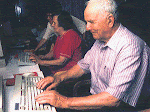"Finding a suitable vein for drawing blood or placing an IV can be challenging, particularly in older or obese patients," explained Portance Samuelson, a nurse at the Mountain View Manor skilled nursing facility in Boulder and recipient of a practitioner certification in Medical Dowsing. "Since I began using medical dowsing to locate good veins, I can hardly remember any instances where I haven't been successful in the first couple of tries."
 |
| A set of medical grade phlebotomy dowsing rods, manufactured by Globodyne Industries |
The addition of locating hard to find veins to dowsing's repertoire was truly a no-brainer. And it originated in Boulder, right down the street from the Mountain View Manor skilled nursing facility. Since 2008, the Institute of Medical Dowsing (IMD) has offered certification to interested nurses and other healthcare professionals. The IMD is actively pursuing national accreditation of their Medical Dowsing Certification (MDC) with the National Commission for Certifying Agencies (NCCA) as well as credentialing from the Institute of Credentialing Excellence (ICE) for their Medical Dowsing Certified Practitioner (MDCP) program. They have successfully obtained approval from the National Acronym Approval Association (NAAA).
 |
| Nurse Samuelson, shown here using dowsing rods to locate a missing patient |
How medical dowsing, and dowsing in general, works remains somewhat of a mystery. Proponents believe that their specially designed tools, often in the form of two L-shaped rods, allow for the detection of subtle energies or vibrations. One school of thought, in regards to medical dowsing, is that the metallic rods are drawn together when over a source rich in iron such as human blood. A hit occurs when the two rods move over one another. X marks the spot, as they say. Or they may point in opposite directions, forming a straight line, to indicate a particularly long segment of blood vessel close to the surface.
Critics have questioned the validity of dowsing, citing the failure to successfully find water under controlled testing conditions and an overall lack of plausibility. But this type of negativity doesn't concern Nurse Samuelson and other proud practitioners of medical dowsing. "I know it works because I've seen the results myself. And patients love it. At the end of the day, isn't that what matters?"

No comments:
Post a Comment